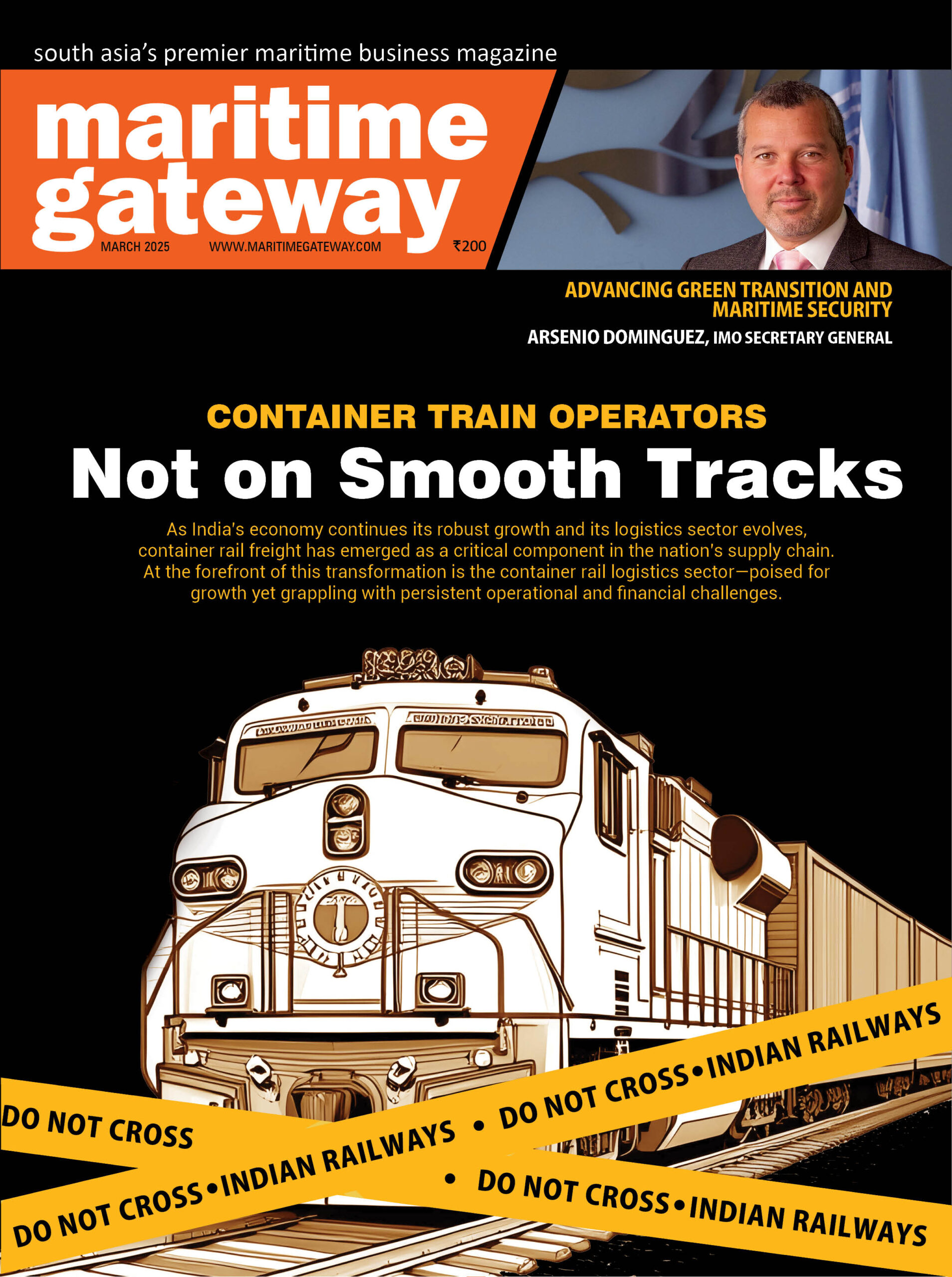“There is a notable increase in the use of biofuel blends in Singapore and Rotterdam. While shipping’s experience with biofuels remains limited, the sector can leverage the learnings from road transport, which has used biofuels for more than two decades,” shares Dr Sanjay C Kuttan, Chief Technology Officer, Global Center for Maritime Decarbonisation.
What is the role of Global Center for Maritime Decarbonisation? Who are your partners and what is their contribution?
Setting up the Global Centre for Maritime Decarbonisation was a recommendation the International Advisory Panel for Maritime Decarbonisation submitted to the Singapore Government in April 2021.
Following this recommendation, GCMD was established in August 2021 as a non-profit organisation founded by six industry partners namely: BHP, BW Group, Eastern Pacific Shipping, Foundation Det Norske Veritas, Ocean Network Express and Seatrium (formerly Sembcorp Marine). GCMD also receives funding from the Maritime and Port Authority of Singapore (MPA) for qualifying research and development programmes and projects.
GCMD’s mission is to support decarbonisation of the industry to meet or exceed the IMO goals for 2030 and 2050 by shaping standards, deploying solutions, financing projects, and fostering collaboration across sectors.
GCMD actively seeks stakeholders throughout the maritime ecosystem who are willing to work with us to accelerate the deployment of scalable low-carbon technologies while lowering the adoption barriers by closing the gaps in infrastructure, safety, operations, and financing.
Tell us about your collaboration with companies for testing sustainable fuels and conducting fuel trials?
GCMD initiated a pilot in July 2022 to establish an assurance framework for drop-in green fuels, starting with biofuels.
This pilot, comprising 6 supply chain trials spread across 3 major bunkering ports – Singapore, Rotterdam and a port in the US, aims to establish an assurance framework for ensuring the supply chain integrity of current and future green marine fuels.
To date, we have completed 3 supply chain trials with biofuels blended with conventional marine fuels at 24% (B24) and 30% (B30) and have deployed a swath of tracing techniques, including the use of physical tracers, carbon dating, chemical fingerprinting and a lock-and-seal methodology to track sustainable biofuels from their production facilities to their consumption onboard vessels. Additionally, industry-recognised documents validating their sustainability standards and certifications were also collected.
Upcoming in our pipeline, we have two other supply chain trials being planned: one out of the Port of Rotterdam with a different tracer and the other out of a port on the west coast of the US, testing a different supply chain. This will enhance the robustness of the assurance framework that is being developed.
The data collected from these three completed trials will form the basis for our assurance framework for drop-in green fuels, which aims to provide emissions abatement assurance to shipowners/ charterers when it comes to paying a premium for green fuels over fossil fuels.
In addition, we are exploring the use of crude algae oil (CAO), a third generation biofuel as a drop-in biofuel for shipping sector. With a high productivity yield i.e., 10-25x, of oil per unit of area/ land, it has the potential to increase the supply of biofuels to support the industry.
CAO also has the potential to meet or exceed MEPC 80’s 65% GHG emissions reduction requirement for biofuels. Since the life cycle assessments (LCA) of CAO is highly dependent on the feedstock, we will be leveraging field data from the producer to evaluate emissions reduction potential of different alternatives, ensuring we choose the right candidate feedstock.
GCMD is studying the properties of CAO, including consistency of CAO quality from a variety of sources, the specifications of CAO and CAO-blended VLSFO against ISO 8217 and the compatibility of its use with engine OEMs.
How is Singapore positioning for bunkering of sustainable fuels or multi-fuel bunkering?
Just last month, Vitol has taken delivery of a specialised IMO type 2 notation bunker vessels that can bunker up to B100 biofuel blends based on customer needs. The use of biofuels, combined with the use of fuel-saving energy efficiency technologies, will also help to meet IMO 2030 requirements.
In addition to biofuels bunker vessels, LNG bunker vessels are also in operation and this established value chain can pave the way for the introduction of bio-LNG in the near future, where bio-LNG can be available as a drop in green fuel. However, for LNG, one must be cognisant over the issue of methane slip. To quantify both upstream and fugitive emissions, LCAs are necessary to achieve emissions reduction targets.
As for future green fuels i.e., bio-methanol, green methanol, green ammonia, we have a mixed scenario. The methanol bunker vessels construction has already been commissioned, following the methanol bunkering trial in 2023 and the deployment of methanol fuelled engines. Meeting the IMO 2030 requirements would depend on the LCA of the methanol being supplied which could depend on the acceptance of mass balance accounting methodologies or the use of drop-in green / low carbon methanol.
In the case of ammonia bunkering vessels, whilst several Approval-in-principal (AIP) has been granted, no final investment decision has been made.
What are the technical challenges to the adoption of low carbon fuels?
Their volumetric energy density is significantly lower than VLSFO or MGO i.e., LNG is about 2x, Methanol ~2.5x, Ammonia ~2.8x and Hydrogen ~4.5x
Flammability and/ or toxicity properties will require special design e.g., double walled piping, handling and safety procedures as well as training for seafarers and bunker operators
Cryogenic nature of LNG and Hydrogen will also increase the technical requirements to handle embrittlement
Notwithstanding these technical challenges, other key considerations, alongside the price point of low-carbon fuel alternatives are also crucial, such as:
Adherence to life cycle analysis of Well-to-Wake GHG emission footprint taking into account of methane slip, nitrous oxide and other GHG to qualify for emission reduction efforts.
High dependency on green hydrogen and biogenic carbon, or effective sequestration or other carbon capture systems dictates low carbon fuels production
How far have the bunkering companies and shipping lines come to terms with biofuel blending?
There is a notable increase in the use of biofuel blends in two major bunkering hubs (i.e., Singapore and Rotterdam). Bunkering volumes rose from a negligible amount in 2020 to a combined volume of 0.3 million MT in 2021, 1 million MT each in 2022 and 2023.
However, the sale of biofuel blends account for only ~1.7% of total bunker sales at these two bunkering hubs. In 2022, biofuels accounted for 0.11% of all fuels consumed by vessels 5,000GT and above; this volume represents only 0.6% to 0.7% of the global annual biodiesel production.
While shipping’s experience with biofuels remains limited, the sector can leverage the learnings from other sectors in road transport, such as trucking, which has used biofuels for more than two decades.
What are the technologies for carbon capture and storage onboard ships? How can shipping lines benefit from this process?
Essentially the technologies can be pre-combustion or post-combustion capture technologies using membrane, chemical or cryogenic methods of CO2 separation
While land-based carbon capture solutions are available, the marinising of these land-based carbon capture solutions is one of the key challenges and require the following to be considered:
- The difference in the installed environment (land vs shipboard)
- Suitability of the chosen carbon capture solutions and storage options
- Management of the captured carbon dioxide
Selection of the different systems and capture targets affects the economic consideration (OPEX and CAPEX) of the installed OCCS system
The OPEX is influenced by the operating fuel, energy, consumables and CO2 offloading activities while the CAPEX is directly linked to the installed configuration of the pre- or post-combustion treatment system and the onboard storage for the consumables and captured carbon dioxide
It is challenging to meet the IMO 2030 target because zero-carbon marine fuels will not be available at scale or at pace globally. It is forecasted that a sizable portion of the two-stroke fuel-mix for large merchant vessel will still be based on a single fuel (fossil and drop-in biofuels) i.e., 85% in 2030 and 34% in 2050.
It is anticipated that before alternative fuels become widely available, these future-ready vessels will still need to operate on existing available fuels. This presents an opportunity for onboard carbon capture and storage (OCCS) systems to assist with the GHG emission reduction.







